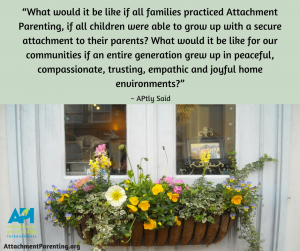Living where we live, wherever each of us lives, it can be difficult to consider how very differently parents in other parts of the world relate to their children.
 You may be living somewhere that nurturing parenting is a foreign concept to anyone outside your family. You may be living somewhere that has a strong, supportive nurturing parenting group.
You may be living somewhere that nurturing parenting is a foreign concept to anyone outside your family. You may be living somewhere that has a strong, supportive nurturing parenting group.
Looking around the globe, researchers have found that parenting styles vary – sometimes starkly – between geographic location, ethnicity, faith, and other cultural differences. Studies tend to agree on three main factors that define these differences in parenting style:
- Emotional warmth – how loving, warm, and affectionate parents are toward children;
- Autonomy – how much children are given a sense of control over their lives;
- Structure – how much children’s lives are predictable and organized.
Related: The 4 parenting styles, what works and what doesn’t
These factors combined have significant influence on child development, including parent-child secure attachment; in other words, the psychological connectedness felt by the child toward the parent, which is then applied to every relationship in that child’s life including in his or her adulthood.
Being able to relate in a healthy, positive way with another human – as the result of secure attachment – is obviously an important piece to that child’s lifelong well-being.
Related: Why early attachment matters for childhood and beyond
So how does a secure parent-child attachment happen? It comes down to the primary caregiver’s sensitivity to her baby/child’s desire for physical and emotional closeness and comfort particularly when baby/child is angry, sad, scared, or otherwise distressed.
How this happens in the (typically) mother-child relationship between birth and age 3 years is foundational, although ideally this sensitive responsiveness would continue through the child’s entire development.
Related: Who will baby attach to?
Related: The chemistry of attachment
This way of relating to our babies and children may be very different than the mainstream parenting culture where you live. It does require a shift in thinking away from the past few generations of advice that derived from the counter-biological idea that parents shouldn’t develop healthy emotional bonds with their children.
If we look at parenting during the Nazi regime in Germany, we see how this “anti-attachment” style of parenting influenced a nation into embracing the Holocaust. A similar trend was started in the United States in the 1920s.
Related: Nurturing doesn’t spoil kids
The research that established the importance of a secure parent-child attachment began in the 1940s, but it wasn’t until the development of brain-imaging technology in the late 1990s that science was able to reinforce the validity of nurturing parenting.
Related: For better or worse, parenting changes your DNA
The invention of the Internet has expanded the reach of science-based, nurturing parenting education and support. However, while the latest trends spread like wildfire, ideas that challenge the status quo – despite those ideas being rooted firmly in research – can take longer to catch hold. Parenting is such a highly personal decision, often embedded with generations of influence.
Related: Historical trauma, breastfeeding, and healing
Part of the difficulty of encouraging more parents to incorporate nurturing back into their parenting style is that many Westernized cultures also extol the thought that the outcome of child-raising is pinned squarely, and almost exclusively, on the mother.
While the mother tends to be the parent with whom a baby/child bases his/her formation of relationship-building skills (secure or insecure attachment), unequivocally the more secure attachments a child develops, the better.
